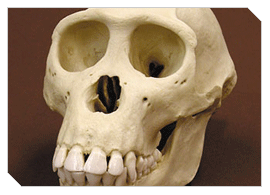

Recently Keith Thompson, a New York artist interested in utilizing new technologies in the creation of his artwork, worked with Direct Dimensions on a great 3D project. Thompson’s specialty is glass sculpture and his pieces often deal with presenting the human form in a reflective medium. His most recent series, called “Reflections”, is based on the 3D digital data from fifteen primate skulls.
“Reflections will feature 15 different monkey skulls. Monkeys are a common motif combined with mirrors in Eastern European arts and crafts - this serves to remind the viewer of our common, primitive roots. These works are illuminated from within, but they also present the viewer with their own reflection; literally and figuratively,” says Thompson. In the finished pieces, the skulls will appear as an image suspended in a thick block of glass. When the viewer looks into the glass they will see their own reflection super-imposed on the primate skull, reminding them of their common origins.
Mr. Thompson initiated efforts with Direct Dimensions on a test skull so that the process and concept could be established. While his earlier works explored silk screening processes, he wanted to explore the use of 3D imaging together with printing in this new series. With the most cutting-edge 3D technologies, Direct Dimensions was up to the task of providing him with precise 3D digital replicas for use in his work.
The DDI technicians initially demonstrated the process by scanning a baboon skull. The raw data was processed into a high resolution watertight 3D polygon model for use within Thompson’s printing process. The process worked so well that the team was asked to scan additional skulls – including a gorilla and chimpanzee.
In order to achieve the precise detail that would be necessary for Thompson to recreate the skulls, the DDI team used a combination of the Faro Arm and a Kreon laser line scanner to provide the ideal resolution for the small features within the skulls. Multiple scans were taken of each primate skull to obtain all the detail and then were digitally combined to create the watertight polygon models of each bone.
While full 3D models were created, Thompson needed only 2D cross sections from the 3D models for his unique printing process. He used the cross sections to print the images in separate sheets of glass. The glass sheets are then fused together to create a full image of the skull that appears to be floating within the block. The glass blocks are then displayed in a lightbox, illuminating the skull within.
You can view Mr. Thompson’s work at:
www.wooloo.org
www.breitengraser.com